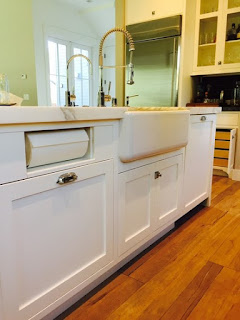Two-Tone Cabinet Finishes Double Kitchen Style
by Lisa Frederick
Love 'em or not, two-tone kitchen
cabinet treatments
are still going strong. Try these strategies to
change up the look of your space
I can't tell you how many articles
I've read lately that proclaim, "The two-tone cabinet trend is dead!"
If I may be the voice of dissent, mix-and-match kitchen cabinet finishes
will be with us for a long time — and there's no reason to ditch them. After
all, they've been around since the days when your average kitchen contained a worktable, some open shelves
and a pie safe or two.
Done right, two-tone (or even three-tone) cabinetry can enhance a space in any
number of different ways, from adding visual weight to introducing texture.
Check out these approaches, each with a different purpose, but all with
stunning results.
Done right, two-tone (or even three-tone) cabinetry can enhance a space in any number of different ways, from adding visual weight to introducing texture. Check out these approaches, each with a different purpose, but all with stunning results.
1.
Create a brilliant focal point. A mannerly cream-colored kitchen comes to life with a
rich red island — the star of the room. Besides drawing attention, it pulls the
tones of the backsplash and the glass-front cabinet interiors into the room.
Bright cabinetry usually works best against a neutral backdrop to avoid an
eye-boggling color competition.
2. Ground an airy space. This light, ethereal kitchen might appear to float away if
it weren't for the bank of rich espresso-brown cabinets that anchors it.
Limiting the palette to two neutral colors helps to maintain the serene vibe.
3. Pull the ceiling down. Conversely, dark cabinets on top and lighter ones on the
bottom can help to make a kitchen feel snug and cozy. A contrasting color is
also a great method of highlighting handsome architecture, such as the
four-pane design of the upper cabinetry in this space.
4.
Bring the shine.
Glossy acrylic base cabinets add a sleek, reflective note to this streamlined kitchen.
Their juxtaposition with the matte island and upper cabinets, as well as the
honed flooring and island countertop, creates an appealing textural interplay.
5.
Diversify a neutral palette. This kitchen could have been a study in brown, but
the glazed peacock blue cabinetry gives it energy and a hit of sass.
Introducing a dramatically different finish is easier and feels more natural
when the cabinetry evokes the impression of freestanding units, like this
hutch-style approach.
6.
Pull the wall hue into the room. Lime green on the kitchen island echoes the paler
shade of the walls for a graduated two-tone effect. The same technique also
works well when you want to repeat a dominant or background color in tile or
wallpaper.
7. Add a barely-there breath of
color. Colors don't have to shout to boost
visual panache. In this quiet, elegant kitchen, silvery gray on the island adds
another nuance to the creamy whites and pale dove grays that cloak the rest of
the space. It lends just enough presence without disturbing the peace.
8. Bridge floors and walls. Sometimes a contrasting cabinet finish can provide a visual
transition between the wall treatment and the flooring. The warm cherry-tone
lower cabinets in this classic kitchen extend the warmth of the brick underfoot
and also create a buffer between the white units and the darker floor and
backsplash materials.










Comments
Post a Comment